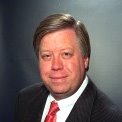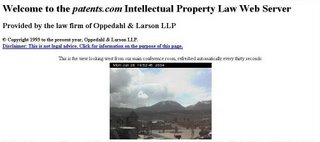"PATENTS.COM" Generic for IP Website, Says TTAB
In a grueling 49-page decision, the Board affirmed the PTO's refusal to register (on the grounds of genericness and, alternatively, mere descriptiveness) the term PATENTS.COM for "on-line information services in the field of intellectual property law provided via [an] interconnected computer network linked by common protocols." In re Oppedahl & Larson, Serial No. 75051843 (March 31, 2006) [not citable].

In applying the CAFC's basic Marvin Ginn genericness test, the Board first determined the genus of Applicant's services. The Board found the genus, "in light of the actual use being made of the term 'PATENTS.COM' by applicant, as principally encompassing the inextricably intertwined element of providing legal information about patents, as well as other kinds of intellectual property, through a website." (slip op., pp. 11-12).
Turning to the second prong of the test, the Board considered whether the relevant public for applicant's recited services uses the term PATENTS.COM primarily to refer to "a category or class (i.e., a genus) of providing information about patents, as well as other kinds of intellectual property, through a website." Applicant O&L argued that the PTO presented "no evidence that it is 'ordinary grammatical construction' to use 'patents.com' as a generic term" for its services. The Examining Attorney argued that this case is congruent with the BONDS.COM and CONTAINER.COM cases.
The Board began its analysis by noting that if PATENTS.COM is considered to be a compound word, the Gould approach would apply, whereas if a phrase, American Fertility would govern. The Gould test would permit a finding of genericness based on dictionary definitions of the constituent words alone. [See the TTABlog discussion of the recent FRESH ORGANICS case, here]. The Board concluded that PATENTS.COM should be treated as a compound word:
"Treating a combination such as 'PATENTS.COM' as a compound term rather than as if it were a phrase 'PATENTS COM' is preferable since, due (presumably) to the technical requirements of Internet domain name addresses, in our experience there can be no space separating any of the individual terms which comprise an Internet address." (slip op., pp. 21-22)
In other words, if one applied the American Fertility test, which requires proof of actual use of the phrase in question, the test would never be satisfied in these types of cases because one would not find generic words like "drugstore" or "bank" used in the form "drugstore com" or "bank com." [i.e., without the dot].
Applying Gould, the Board found "clear evidence" that PATENTS.COM is understood by the relevant public to be generic: it understands "patents" to be generic for certain intellectual property grants, and ".com" to be generic for a top-level domain identifier of a commercial entity.
"In view thereof, joining the terms 'patents' and '.com' to form the designation 'PATENTS.COM' results in a compound term which, to the relevant public for applicant's services of providing legal information about patents, as well as other kinds of intellectual property, through a website, primarily signifies a commercial website which provides legal information about patents." (slip op., pp. 25-26)
Moreover, the joining of these individual terms into the compound term PATENTS.COM "lends no additional meaning to such term as a whole."
Turning to the Section 2(e)(1) issue, Applicant O&L contended that "for technical reasons, any internet domain name is inherently distinctive and thus cannot be merely descriptive." The CAFC, however, disposed of that argument in In re Oppedahl & Larson LLP, 71 USPQ2d 1370 (Fed. Cir. 2004):
"The simple fact that domain names can only be owned by one entity does not of itself make them distinctive or source identifying. Telephone numbers and street addresses are also unique, but they do not by themselves convey to the public the source of specific goods or services." 71 USPQ2d 1374.
Based on dictionary definitions and other evidence, the Board ruled that PATENTS.COM is merely descriptive of O&L's services: "[C]ombining the terms 'PATENTS' and 'COM' into the compound term 'PATENTS.COM' results in a designation which would only signify a commercial website which provides legal information about patents." (slip op., p. 35).
The combination PATENTS.COM does not create a connotation different from that of the two terms. "[A]s was found in [by the CAFC] in Oppedahl, considering the term 'PATENTS.COM' 'as a whole only strengthens the descriptiveness finding.'" 71 USPQ2d 1374. This is not one of those "rare instances" when the addition of a TLD indicator to a merely descriptive term creates a distinctive mark.

As to O&L's claim of acquired distinctiveness, the Board found that Applicant's evidence "falls far short of its burden of demonstrating acquired distinctiveness" of the highly descriptive term PATENTS.COM. Given that "the greater the degree of descriptiveness the term has, the heavier the burden to prove it has attained secondary meaning," O&L's claim of five years of substantially exclusive and continuous use "is plainly insufficient."
Applicant's evidence regarding the number of hits at its website and the number of third-party websites that link to O&L's website is "at best an indication of the popularity" of the website, particularly in light of O&L's lack of evidence showing that PATENTS.COM is used "in the manner of a service mark." The sole evidence of use as a service mark was the specimen shown above, but "there is absolutely no evidence as to how long the term 'PATENTS.COM' has been so used nor is there any evidence that applicant has advertised or otherwise promoted its services."
The Board therefore rejected the Section 2(f) claim, and affirmed the refusals to register.
TTABlog note: The fancy but ultimately futile footwork of O&L in submitting the above-depicted specimen of use into the record was TTABlogged here.
Text Copyright John L. Welch 2006




0 Comments:
Post a Comment
<< Home